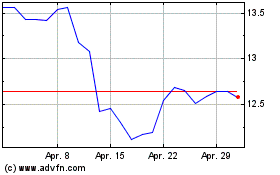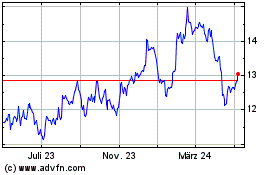By Drew FitzGerald and Sarah Krouse
The current generation of wireless technology ushered in a host
of new smartphone applications that helped put the mobile phone at
the center of e-commerce, socializing and navigation.
The next wave of wireless -- 5G -- will supercharge cellphones,
but its real strength lies in its potential to power the "Internet
of Things," a byword for everything electronic other than the
smartphone.
That includes factory production lines that get instructions
over the air instead of through wires; driverless cars that receive
incredibly detailed information about road conditions in real time;
sports broadcasts that let viewers see the game from a dizzying
number of angles, and get a host of new statistics superimposed on
the screen to reflect the action; and wearable devices that monitor
a patient's physical condition and beam the information to
doctors.
These are just some of the developments that may be in store as
5G networks evolve and as carriers look for growth opportunities
outside of the mature cellphone market in developed countries.
Here's a rundown of how this new telecom technology could transform
six industries, how long those changes might take and what
obstacles stand in the way.
Flexibility in the factory
Factories have relied on physical wires for more than a century
-- for good reason. A spotty wireless connection can cause
machinery to move too slowly or misfire, with expensive and
potentially dangerous consequences.
Wireless engineers say 5G's emphasis on slashing latency -- the
amount of time that machines take to respond to each other -- could
challenge that status quo. The network's responsiveness would allow
robotic assembly lines to take instructions over the air or grab
the latest specifications for a product without lagging, so they
could remain on the job all the time. Mobile robots could also be
on the move constantly without having to plug in.
"This is sort of the Holy Grail of factory automation," says
Gerhard Fettweis, a professor of mobile communications at Germany's
TU Dresden. "There's nothing nailed to the floor."
In Germany, cellphone carrier Deutsche Telekom AG launched in
2018 a pilot factory program designed to test what kinds of
machines benefit from enhanced wireless service. The program's
specially designed 4G networks will get a 5G upgrade once new
wireless spectrum is available for use, a spokesman says.
Telecom companies in Germany and China have so far shown the
most interest in fostering 5G manufacturing, according to Chetan
Sharma, industry analyst for his eponymous consulting firm. He
predicts growing interest from manufacturers that might face sudden
orders that their existing workforce can't fulfill.
Still, he doesn't expect wireless networks to touch every part
of the production process right away. A slower-growing company that
makes metal goods or paper products, for instance, isn't likely to
spend precious capital on wireless technology. And he doesn't think
that factory owners are likely to start cutting the cord on
robotics soon.
Mr. Sharma says computer-chip makers must first develop
specialized hardware for the sector before factories will be
willing to risk installing wireless 5G machinery, a process that
will take several years. "Redoing the manufacturing workflow
demands certainty," he says.
Cars get fueled up with data
Experts expect to see vehicles equipped with 5G modems in the
coming years. Still, what the next generation of connected cars
will look like is an often-contentious question.
Some telecom-industry leaders paint a futuristic picture of
driverless vehicles getting real-time information about traffic and
hazards as they move, and then reacting to them. It is a vision
that takes advantage of the strength of 5G networks -- their
ability to juggle swarms of simultaneous connections, allowing
sensors in cars and on streets to provide uninterrupted streams of
precise data.
But skeptics say telecom companies are overselling the
capabilities of 5G when it comes to vehicles. The next generation
of wireless networks, like its predecessors, will sometimes fail.
And it might take years for even urban areas to get 5G signals
everywhere.
"Nobody in their right mind would make a driverless car
dependent on the wireless network for critical functions like
braking and steering," says Craig Moffett, analyst at research firm
MoffettNathanson. Any reliance on a 5G connection, he says, "would
require ubiquitous networks, which we won't have in our
lifetimes."
Some companies are pitching more-limited uses for 5G
transportation, at least to start. AT&T Inc. executives have
said that small, neighborhood-size 5G zones could be a good place
for public-transit riders and car passengers to keep themselves
amused by downloading video and games as they pass through the
area.
"We think it's going to pop up in zones centered around
campuses" early on, John Donovan, chief of AT&T's telecom
business, said in an interview last year.
An AT&T spokesman says the company is also developing
technology with partners to allow cars to share information with
each other and roadside service stations when they fall outside the
range of a cell tower. That could mean sharing information about
things like road hazards, or getting in touch with emergency
services.
A new angle on sports
When South Korea's KT Corp. offered a version of its 5G
technology at the Winter Olympics in Pyeongchang last year, the
telecom giant allowed visitors to fiddle with the angle from which
they viewed an event -- such as seeing a game from the perspective
of athletes.
That was a preview of how professional sports leagues are
planning to reshape their content using 5G connectivity. For
instance, viewers can expect to have regular sports enhanced with
the same 5G boost as the Korean games. Technology under development
will use a host of cameras and sensors installed throughout sports
venues to let fans choose among numerous angles for viewing
athletic contests.
"You can literally run around like LeBron James," says Roger
Entner, chief of wireless-industry research firm Recon Analytics
Inc.
Other technology wouldn't just offer new angles on the field of
play, it would offer viewers more information about the action.
Intel Corp. experimented with attaching sensors to players and
pucks at the 2019 National Hockey League All-Star game in January.
Viewers could pull up a host of new statistics on their phones to
see how fast shots went into the goal and how fast skaters moved
down the ice. The steps were a precursor to providing fans more
real-time statistics on their phones or customized on their
television screens during games, once 5G is deployed.
More immersive movies and games
Hollywood studios and videogame companies are looking to
leverage 5G's speed and ultralow latency to give viewers a much
more immersive experience -- whether they're watching on a TV or
with a headset.
"More so than sitting back and watching TV, you're going to be
living life in a virtual world. People could be anywhere, including
imaginary worlds," says Ron Yekutiel, chief executive of
video-platform provider Kaltura.
Studios have tested applications that give a taste of what the
5G future might bring. But they're still trying to figure out just
what content and pricing will get the best response from
viewers.
A $20 virtual-reality experience in 2016 tied to the release of
Twentieth Century Fox's film "The Martian," for example, received
mixed reviews from audiences. The VR content allowed people to move
through a Mars-like environment like the movie's hero, played by
Matt Damon.
Robert Powers, executive director, global technology and
business development for Fox Innovation Lab, says $8 to $15 is a
more palatable price range for consumers for VR experiences. Fox is
also working on augmented and mixed-reality experiences -- where
computer-generated graphics are overlaid over real-world images --
that 5G will help facilitate.
For example, last summer the lab worked on a mixed-reality
experience in which a person moved through a story using their
mobile phone or wearable device in a public space like a theme
park. While walking, the player followed prompts and saw
superimposed figures that could move around and interact with the
user.
A new doctor-patient relationship
In the coming years, 5G will make it possible for doctors to
have more interactions with their patients through new telemedicine
avenues, such as high-quality videoconferencing and virtual
reality, says Sandra Rivera, general manager of Intel's
network-platforms group.
Boosters say the upgraded networks will make even bigger changes
possible, such as having a doctor in one corner of the world
operating on a patient in another with remote-controlled surgical
machines. Less grand, but coming sooner, is a wave of changes
bringing more-personalized care.
A therapist remotely treating a child with autism, for example,
could use a VR headset to see the child's facial and body cues more
clearly than is possible on today's video calls via mobile phones.
Columbia University researchers, meanwhile, are working on virtual
physical therapy helped by 5G's low latency. A patient wears a
virtual-reality headset and moves controllers to manipulate digital
versions of physical objects like a ball, mimicking motions in a
traditional therapy session.
New sensors and wearable devices connected to 5G networks that
generate data will also help flag abnormalities or adjust the
dosage of medicine or therapeutic activities without in-person
visits. Patients could wear sensors that monitor their activity,
stress levels and blood sugar, with that data flowing to their
physician, Ms. Rivera adds.
Later on, 5G's faster speed, lower latency and higher bandwidth
could facilitate larger changes such as paramedics getting
real-time instructions in an ambulance from a trained physician
using high-definition cameras and virtual reality.
Making surveillance more precise
Cameras and sensors already blanket the busier corners of the
world without the help of 5G technology. But an experiment that
Verizon Communications Inc. recently ran at a Houston testing
center offered a peek at what the world could look like when faster
wireless service becomes commonplace.
Early experiments suggest cameras and sensors with 5G
enhancements could allow police departments to scan public places
more quickly for suspects in their databases. It could also allow
stores to track their customers' movements with more precision,
perhaps allowing them to tailor marketing to them based on their
behavior.
Engineers at the wireless carrier developed customized software
that allows computers to process images near a cell tower rather
than in a data center hundreds of miles away.
The test took advantage of two 5G benefits. Enhanced bandwidth
allows cameras to pass data-heavy images over the air without
degrading their quality. Lower latency also lets computers process
images close to where they are captured, allowing them to quickly
identify people and objects. Verizon says the on-site processing
led its systems to find matching images twice as fast as they could
using conventional methods.
Adam Koeppe, Verizon's senior vice president for network
planning, says public-safety groups often ask for the ability to
make better use of surveillance data. Similar technology could also
be used by retailers to track foot traffic.
"This type of technology is not new," he says. "The question is,
how do you deploy it in a mobile environment?"
Mr. FitzGerald is a Wall Street Journal reporter in Washington,
and Ms. Krouse is a Wall Street Journal reporter in New York. Email
andrew.fitzgerald@wsj.com and sarah.krouse@wsj.com.
(END) Dow Jones Newswires
February 26, 2019 22:20 ET (03:20 GMT)
Copyright (c) 2019 Dow Jones & Company, Inc.
KT (NYSE:KT)
Historical Stock Chart
Von Mär 2024 bis Apr 2024

KT (NYSE:KT)
Historical Stock Chart
Von Apr 2023 bis Apr 2024
